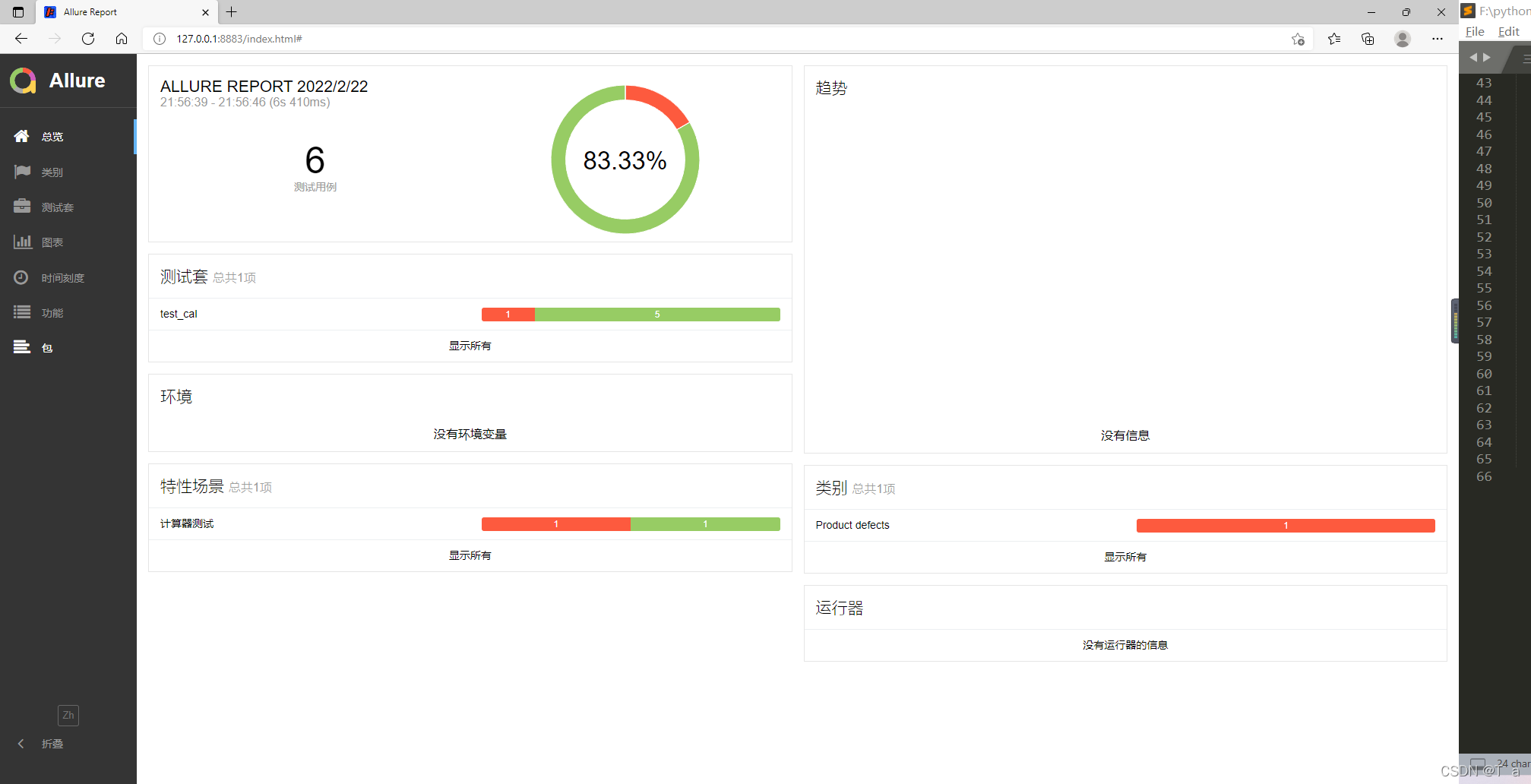文章目录
前言
pytest及allure的使用
一、pytest的基本用法
1.测试文件、测试函数、测试方法用test_开头。
2.测试类以Test开头
3.测试类中不能包含构造方法(__init__)
4.运行测试文件 pytest -v -s 测试文件
二、使用步骤
1.安装插件库
1.失败重跑插件
pip install pytest-rerunfailures
2.指定案例执行顺序插件
pip install pytest-orderinag
3.多线程执行插件
pip install pytest-xdist
4.添加多条断言插件
pip install pytest-assume
5.命令行美化插件
# 安装即可使用
pip install pytest-sugar
6.安装allur插件(须在本地安装allure且配置环境变量)
pip install allure-pytest
2.引入库
代码如下(示例):
import pytest
import allure
3.使用pytest
- 多次执行失败案例: - 重跑次数:3 等待时间 1s-
pytest -vs test_cal.py --reruns 3 -delay=1- 添加装饰器指定案例失败重跑
@pytest.mark.flaky(reruns=3, reruns_delay=1)
def test_add(self):...
- 指定顺序执行案例:
@pytest.mark.run(order=2)
def test_2(self):...
@pytest.mark.run(order=1)
def test_1(self):...
- 多线程执行案例:-
pytest test_cal.py -n 3 - 添加多条断言,断言都可执行:
pytest.assume(加入断言)
pytest.assume(加入断言)...
- pytest 参数使用: -
pytest -v -s 详细输入每条案例的执行日志信息及print输出内容-pytest -k 方法名 跳过该方法名的测试案例-pytest -x 案例失败即停止运行-pytest --maxfail=[3] 失败案例数达到3条即停止运行 - pytest前置条件及后置条件设置(类似与setup与teardown方法,但功能更加强大,可满足不同的测试前置条件) -
以 @pytest.fixture() 装饰函数,将被装饰的函数名以参数形式参入测试方法中
@pytest.fixture()
def login():print("测试开始")
yiled
print("测试结束")
class TestDemo:
def test_1(self, login):...
- pytest参数化设置(第一种) -
以@pytest.mark.parametrize(" userid, password,...",[(),(),...]) 装饰测试方法,并传入具体的参数名称及具体参数
@pytest.mark.parametrize("a,b,c",[(1,2,3),(2,3,5)])
def test_a(a,b,c)
add_result = a+b
assert add_result == c
- pytest参数化设置(第二种) -
以@pytest.fixture(params=[(1,2,3),(2,3,5),...])装饰函数,函数返回参数,将被装饰函数名以参数方式传入测试方法中
@pytest.fixture(params=[(1,2,3),(2,3,5)])
def get_data(request):
data = request.param
return data
def test_b(get_data):
add_result = get_data[0]+ get_data[1]
assert add_result == get_data[2]
4.使用allure
- allure添加测试类名,方法名,步骤: -
@allure.feature("测试类名")-@allure.story("测试方法名")-with allure.step("测试步骤") - allure添加案例的等级: -
@allure.severity(allure.severity_level.CRITICAL)-blocker:阻塞缺陷(功能未实现,无法下一步)-critical:严重缺陷(功能点缺失-normal: 一般缺陷(边界情况,格式错误)-minor:次要缺陷(界面错误与ui需求不符)-trivial: 轻微缺陷(必须项无提示,或者提示不规范)
可通过命令行执行设置了对应等级的案例:
pytest test_cal.py --allure-severities=critical
- allure添加测试链接: -
@allure.testcase(url,"测试地址") - 通过allure生成测试报告: -
指定测试数据保存目录:pytest -vs test_cal.py --allure-features="计算器测试" --alluredir=./allure_result-打开allure报告:allure serve ./allure_result-生成html测试报告:allure generate ./allure_result -o ./report --clean-启动web服务打开报告:allure open -h 127.0.0.1 -p 8883 ./report
5.pytest+allure生成的测试报告:



- conftest.py主要代码:
import pytest
import yaml
from calculator.cal import CalculatorDemo
with open("../datas.yaml", encoding="utf-8") as f:
datas = yaml.safe_load(f)
add_data = datas['add']['datas']
add_ids = datas['add']['ids']
sub_data = datas['sub']['datas']
sub_ids = datas['sub']['ids']
@pytest.fixture()
def start():
cal =CalculatorDemo()return cal
@pytest.fixture(params=add_data, ids=add_ids)
def get_data(request):print("测试开始")
data = request.param
yield data
print("测试结束")
@pytest.fixture(params=sub_data, ids=sub_ids)
def get_sub(request):print("测试开始")
data = request.param
yield data
print("测试结束")
- 测试代码-test_cal.py:
import allure
import pytest
@allure.testcase("https://www.baidu.com","测试地址")
@allure.feature("计算器测试")
class TestCal:
@allure.story("加法测试")
# 设置失败案例来重跑次数,及重跑次数的时间间隔
@pytest.mark.flaky(reruns=3, reruns_delay=1)
# 设置案例的执行顺序
@pytest.mark.run(order=2)
def test_add(self, start, get_data):
with allure.step("步骤1:获取加法结果"):
result = start.add(get_data[0], get_data[1])
with allure.step("步骤2:判断结果的类型"):ifisinstance(result,float):
result =round(result,2)print(f"测试结果是:{result}")
assert result == get_data[2]
@allure.story("减法测试")
@allure.severity(allure.severity_level.CRITICAL)
@pytest.mark.run(order=1)
def test_sub(self, start, get_sub):
with allure.step("步骤1:获取减法结果"):
result = start.sub(get_sub[0], get_sub[1])
with allure.step("步骤2:判断结果的类型"):ifisinstance(result,float):
result =round(result,2)
assert result == get_sub[2]
总结
pytest与allure的基本使用,工作中遇到更好的插件及方法,会继续更新,继续学习。
版权归原作者 T a 所有, 如有侵权,请联系我们删除。